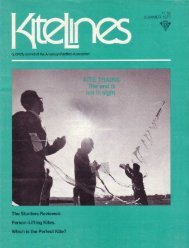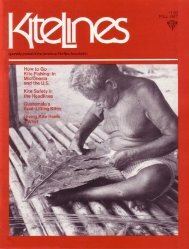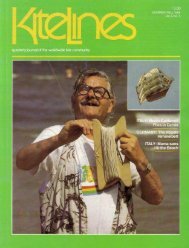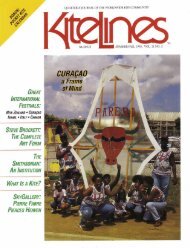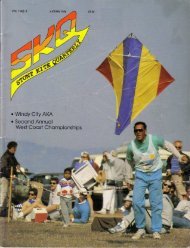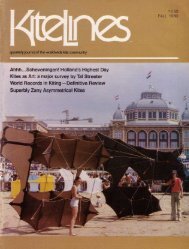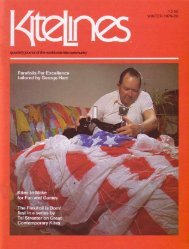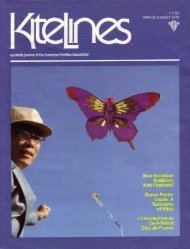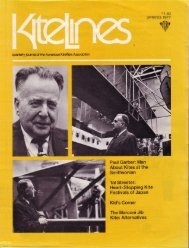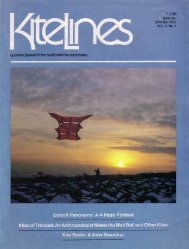Kite Lines - Vol.2 No. 4 - KiteLife
Kite Lines - Vol.2 No. 4 - KiteLife
Kite Lines - Vol.2 No. 4 - KiteLife
- No tags were found...
Create successful ePaper yourself
Turn your PDF publications into a flip-book with our unique Google optimized e-Paper software.
LettersCOFFEE STIRRERS TO THE RESCUEI have left for a while Israel and my goodkite friend Alex Cohen and his family totake up a post in the cardiac surgery departmentof Montefiore Hospital where Iwork as a biomedical engineer .On arrival in New York we stayed at ahotel on 44th Street, close to Benihana ofTokyo . Walking past that famous restaurant,we saw an advertisement for NewYork's Benihana/Go Fly a <strong>Kite</strong> Festival .<strong>No</strong>t having brought my kite collectionfrom Israel, I raced up to the hotel roomarmed with coffee stirrer sticks and somepaper napkins lifted from a nearby pizzaplace where we ate, and glue and threadfrom the local 69-cent store . I quicklyput together a white Conyne about threeinches tall.Came the big day and we were off uptownto Sheep's Meadow in Central Park .The skies were full of beautifully coloredkites of varied shapes, sizes and types .The whole family was really excitedwhen we received first prize in the smallestkite class-dinner for two at Benihana'sand 10,000 yen . It was a great experienceand welcome to the Big Apple for all of us .Eliezer Astrinsky, Ph .D .Bronx, NYAT THE STAGE BEFORE NOVICEMy son recently gave me a subscription toyour journal . I was so fascinated by thefirst issue d <strong>Kite</strong> <strong>Lines</strong> I received that Isent for all the previous issues and havebeen patiently reading them cover to coverat every spare moment . I soon discoveredthat I was at the stage before novice . Asin the practice of medicine, I learned thatfor every fact I knew there were thousandsI didn't know.Eugene L . Lozner, M .D .Tampa, FLTALES FROM THE TAILLESSMy interest in kiting lies mainly in thesingle-line high flying category . <strong>No</strong>thingpleases me more than to have my kite upin the clouds, invisible, and my line lookinglike the Indian rope trick .<strong>No</strong>w to do this it is necessary to have athoroughly reliable kite, and my effortsto make this seemingly simple article havebeen many and varied .I have made quite a few box kites,mostly winged ones, both triangular andsquare, and they have usually flown quitebeautifully . Their main drawback is in thenumber of spars required ; these have tobe kept as light as possible, being so many,and in strong winds some may break . Ifyou are flying in an airfield or on an openmoorland, that is not too bad, but in semirestrictedplaces it could be a disaster .So I turned my attention to single surfacekites, such as the Eddy, Malay, Parakiteor whatever you like to call them . Ihave spent a considerable amount of timeand money on trying to construct one ofthese which will fulfill the statementsmade in many books that they are tailless .They are not . Possibly flown in steady seasidebreezes or in a light wind on an airfield,they may be, but flown in varyingconditions and particularly for high flyingexpeditions they are totally unreliable .Flown with a drogue attached they aremore steady . A drogue needs to be assmall and light as possible to retain highangle flying, so I devised a kite which Ihoped would enable me to use a lightdrogue, which would be more compensatingfor different wind conditions . I didthis by giving the drogue more leverageon which to operate its drag by fixing avery light spar rigidly across the bottomof the kite at the end of the spine . Thetail is then composed of two lines whichconnect to the drogue itself by means ofa swivel link, to prevent twisting . This hasthe effect that immediately the kite turnsfrom the vertical it has to lift the droguemuch more than when the latter is simplyattached to the spine by a single line . Inormally use a six-foot kite and find thata '/a-inch dowel 18 inches long works welland adds very little weight .When making these kites I abandonedvery early on the usual pocket arrangementfor housing the ends of the spars .They simply do not stand up to the strainupon them and eventually wear throughhowever well they are reinforced . Alsothey put too much strain on a small areaof the fabric and tend to pull the kite outof shape eventually . I use rings now, andthe spars are attached by means of tapes,which are readily renewable when required. In making these kites, therefore,I cut off the corners and fold back thematerial so that a small piece of dowelcan be inserted to take the strain of attachingthe ring. The base of the kite is cutback even more so that when hemmed itwill accommodate the 18-inch dowel .There are various ways of designingthese kites-rigid with bowed cross spar,nonrigid with floating cross spar, rigidwith straight cross spar held back by aspacer, etc . I use the nonrigid arrangementin mine. One of the troubles I foundwas that the kite made with a straightspine would frequently dive forwardtowards me, in the manner of a delta . Icorrected this by making the spine angleback from a point about 18 inches fromthe top . The total deflection is fairlysmall-about three inches in a six-footkite-and it means splicing the spine, butit is effective .This is the kite I use for real high flying,and it works . For normal recreationalflying I use box kites . They are tailless,predictable and above all strikinglyinteresting to watch .F . W . ColesBingley, Lancastershire, EnglandA PUZZLE AND A THEORYCan you or any of your staff help mesolve a vexing problem?I have lost at least five good kites thesame way . It's this .In trying to fly a kite over water off adock with an offshore breeze, as soon asthe kite gets about 30 feet up in the air itturns over and comes smashing down intothe water . Can you tell me the reason?Harold SmithPortland, Ontario, CanadaPete Ianuzzi has experienced the phenomenonyou describe and has this theory toexplain it . In the warmer months the normaltendency is for the breeze to betoward the ocean in the morning andtoward the land in the afternoon . This isbecause the land changes temperaturefaster than the water; in the morning it iscooler than the water but by afternoon itis warmer. Warm morning air over theocean rises and is replaced by cooler offshorebreezes. This reverses in the afternoon,when the warmer air rises on theland and cooler breezes come onshore(creating that summer relief that has attractedvacationers since the days beforeair conditioning) . There is a time, forabout an hour in the late morning (fromPete's experience), when the airflow ischanging from sea to land . At this time,at the edge of the ocean, a kite will go upover the land where the air is starting to



